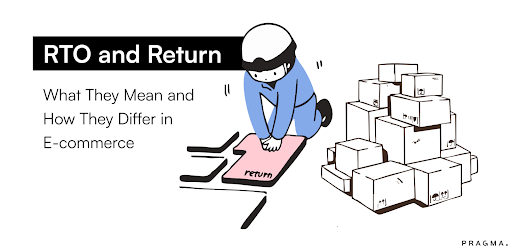
In this blog, we’ll discuss about RTO Suite - Analyse, Identify and Eliminate RTOs at every Stage.
Let’s get started.
RTO meaning in Courier
What Does RTO Mean in Courier?
RTO in courier services refers to 'Return To Origin.' It signifies the process where a package or shipment is returned to its sender or origin due to various reasons such as delivery failure, incorrect address, refusal by the recipient, inability to collect payment (in the case of cash on delivery), or expiration of the storage period at the delivery location. To eliminate RTO in ecommerce, implementing strategies such as verifying customer information and analyzing prior data is crucial.
Couriers use the term RTO to denote the return of undelivered shipments to their point of origin.
What Is Return-to-Origin (RTO)?
Return-to-Origin (RTO) is a term used in logistics and courier services to describe the process where a package or shipment is returned to its sender or origin.
This occurs when the delivery of the package fails due to reasons such as incorrect address, refusal by the recipient, inability to collect payment (in the case of cash on delivery), or expiration of the storage period at the delivery location. The courier company handles the RTO process, returning the undelivered package back to the sender's address or central hub for further action, such as reshipment, refund processing, or disposal.
How to Avoid Common RTO Mistakes
Return to Origin, or RTO, make up over 20-30% of all orders. Meaning, you straight-up lose 20% of possible revenue gained due to RTOs. Limiting Return to Origin shipments is essential for maintaining profitability. Hence Pragma's RTO Suite!
Meaning, you straight-up lose 20% of possible revenue gained due to RTOs
This is where Pragma’S RTO REDUCTION ALGORITHM comes in !!!
1. Fraud & User Analysis
- Customer info check
What it does to reduce RTO? - Details such as address and phone number are verified. And if the delivery address is a temporary address such as a hostel, resort, PG, etc, then the order is automatically flagged.
Example - if there is a digit missing in the contact number provided, or a non-existing pin-code has been used in the address. In these cases, the user is contacted while still on the site and informed.
- Prior data analysis
What it does to reduce RTO? - Most orders are not first orders, meaning, there is pre-existing information on previous purchases (from various eCommerce sites). The algorithm analyses this gathered data and can now tell the number of previous order cancellations, if the same order was placed in multiple sites etc., and red flag the order if suspicious - this way you can review the flagged order and accept or reject them.
Example - if the same product was bought twice on your site and on the same day; it could be a mistake made by the consumer. So, the order will be flagged. Now you can send a message asking for confirmation and proceed.
- Log data analysis
What it does to reduce RTO ? - This step is to reduce impulsive purchases, which directly impact RTOs when they fall under the COD mode of payment - if the order is not received, the product will have to be shipped back and the seller would incur losses.
To avoid that, the algorithm would use the duration of the consumers' time on your site along with other data to make the decision.
Example - If the time taken to purchase was too short; it would mean the consumer did not read about the product, its policy, etc. Thereby making them an impulsive buyer.
Note: Our system doesn’t just flag orders, but it also provides you with the information as to why they were flagged. And you can choose how the flagged orders are handled based on severity.
2. Geoanalysis
What it does to reduce RTO? - The feature basically pinpoints locations with the highest rate of RTOs in the regions you target. And based on that day you can target your promotions and sales on regions which show better results instead of reaching out to consumers in areas that have high RTO rates.
Example - If area ‘x’ has a 90% RTO rate and area ‘y’ has only 20% RTO rate with thrice the volume; it’s wise to target your strategies on ‘y’ over ‘x’
Geoanalysis effectively helps in reducing operational costs by 10 to 20%
3. COD Verification
What it does to reduce RTO? - Pragma sends automated notifications to your customers at the right time based on customer convenience data. And this Automation is the greatest advantage of COD verification - no manpower, zero human error.
And another plus would be the marketing opportunity while sending these messages - every confirmation WhatsApp, SMS or Email can be accompanied with suggestions based on the purchase, offers, etc.
Example - If the customer has read the messages and hasn’t responded by verifying, the Pragma system will then recommend cancellation.
10-15% of COD verified orders are cancelled, therefore stopping RTOs at their root, helping Brands Reversing RTO Losses.
4. C2P (COD to Prepaid) Conversion
What it does to reduce RTO? - The system sends seller-approved offers to convince customers to convert their orders to paid via WhatsApp, SMS, and/or Email.
Example - A coupon code for 10% discount in the next order urging the customer to convert COD to Prepaid.
A method that is proven effective, showing a 25 to 35% increase in paid orders post our C2P initiative
5. NDR Management
What it does to reduce RTO? - Tied with major courier partners, we enable efficient real-time shipment tracking - this allows us to also assist you when it comes to NDRs.
On delivery exceptions (NDR), a message is sent to notify the customer automatically via WhatsApp, SMS, and/or Email to collect feedback - and if the situation can’t be settled after taking the necessary steps, an NDR is generated automatically.
Example - In case of unavailability of the consumer during delivery or any other issues faced by the delivery partner, a message is sent to the consumer asking if they need to reschedule the delivery.
Vice versa, if the consumer is present, yet the delivery partner has not delivered; then a message is sent to the delivery partner to confirm the issue.
This way an SLA breach can be monitored and can be acted upon with ease.
Realtime NDR assistance helps keep your Logistics Provider in check, while keeping customers in the loop - resulting in increase in fulfilment rate by 12 to 15%
Why Pragma?
TOTAL ORDERS MANAGED - 76,41,384
RTO REDUCTION ON AVERAGE - 36.06%
NDRs REDUCED - 3,24,144
INCREASE IN UPI/PRE-PAID ORDERS - 4.49%


FAQs (Frequently Asked Questions On RTO Suite for D2C Brands: Analyze, Identify, and RTO Issues)
1. How does Pragma’s RTO Reduction Algorithm help?
It verifies customer details, flags suspicious orders using past purchase data, identifies impulsive buyers from site engagement, and prioritises order reviews to minimise faulty deliveries.
2. What is geoanalysis in RTO management?
Geoanalysis identifies areas with high RTO rates to focus marketing and sales efforts on low-risk regions, reducing operational losses by 10-20%.
3. How does COD verification reduce RTO?
Automated notifications sent to customers prompt order confirmation; non-responsive customers may have orders cancelled, reducing 10-15% of RTOs at the root.
4. What is COD to Prepaid (C2P) conversion?
Offering incentives like discounts to convert orders from cash-on-delivery to prepaid payment methods, shown to increase paid orders by 25-35%.
5. How can brands avoid common RTO mistakes?
Verify customer info, analyse prior order data, monitor suspicious behaviour, geo-target based on RTO patterns, and manage COD orders with automated confirmations.
Talk to our experts for a customised solution that can maximise your sales funnel
Book a demo


.webp)
.webp)
.png)